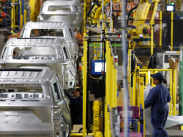Cities aren’t great at measuring how much pollution they emit and not just by a small margin — the average underreporting error is over 18%.
These miscalculations were uncovered in a study published this week in the journal Nature Communications. The researchers suggested that if an error that size was extrapolated across all American cities, the resulting annual missed emissions would be some 25% higher than the emissions of the entire state of California.
Cleveland was one sizeable city called out in the report for greenhouse gas measurements that are off by 90%. But city calculations missed the researchers’ count in the other direction as well: tech hub Palo Alto, Calif., may be overreporting emissions by 42%.
The report’s authors said their research didn’t turn up signs of intentional miscounting to sway policy. Rather, data collection and assessment was flawed.
Almost 75% of greenhouse gas emissions come from the U.S.’s fast-growing cities, a hundred-plus of which have pledged to aggressively limit their emissions. Projections show cities could add over 2 billion people this century with global urban area tripling by 2030.
Read: COVID-19 helped the U.S. near Paris emissions goals but the retreat will fade without renewables
Local leaders have been spurred on lately by a Biden administration pledge to tackle climate change across sectors and as more of the private sector gets on board. This attention could help ensure accurate data collection, advocates hope, as without better data, legislation and other policy moves could miss the mark.
The study compared the cities’ own emissions reports with estimates derived mainly from publicly available federal data on sources including factories and power plants, census areas and traffic and road information.
Read: Nuclear and carbon capture may form bipartisan (re)starting point on climate change
Biden has called for $2 trillion in spending to reduce emissions to net-zero by 2050, which is seen as key to slowing manmade global warming. He intends to shore up infrastructure and is promoting electric vehicles, among other steps. Biden used an executive order to rejoin the Paris Climate Agreement. His administration has pledged to stop new oil and gas drilling permits on some land, but won’t stand in the way of existing contracts.
Read: The big challenge to Biden’s electric-vehicle pledge — not every state is on board
Separate studies by researchers at the University of Michigan, Harvard and the federal government have found that emissions of methane, another powerful greenhouse gas, were also undercounted by many cities.
Analysts dissecting the national standards and Biden targets are quick to remind that much of the heavy lifting toward combating climate change will need to occur on a local scale.
Kevin Gurney, the lead author of the paper and a professor at Northern Arizona University’s School of Informatics, Computing and Cyber Systems, told the New York Times that cities have mostly launched well-intentioned endeavors to curb climate change but “they haven’t had a lot of tools to do it.”







